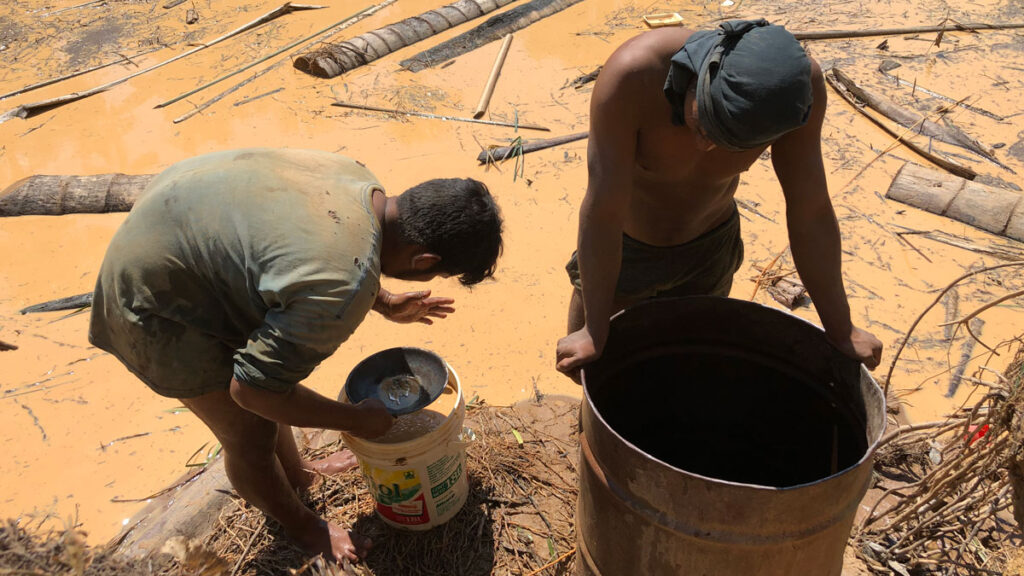In the southeastern corner of Peru, the Madre de Dios River courses eastward, eventually emptying into the mighty Amazon. Verdant rain forests grow in sandy, gold-flecked soils.
Today, gold miners fell the forest’s trees, sluicing the sediment, removing the sand. To wrest the precious metal from this mix, miners add liquid mercury, which scavenges the gold and forms an amalgam with it. By torching the resulting goo, miners can burn off the mercury. Hazardous fumes rise skyward, and gold is left behind.
In recent years, the Peruvian government has expelled gold miners from protected areas of Madre de Dios, the region through which the namesake river flows. In the wake of these interventions, hydrologist Evan Dethier, a postdoctoral fellow at Dartmouth College, and his colleagues tracked forest recovery and followed the trail of ousted miners by using satellite imagery to search for telltale signs of ongoing gold extraction: yellow-tinged, sediment-laden ponds pocking the forest. They found that where miners have been expelled, revegetation is sparse. They also discovered that many miners appeared to move elsewhere, often to the nearest parts of Madre de Dios where mining is legal. Dethier will present the team’s results on 15 December at AGU’s Fall Meeting 2021.

Mining Migrations
During the second half of the twentieth century, migrants cascaded from the Andes into Madre de Dios in search of work in gold mining, said Jimena Diaz Leiva, an interdisciplinary environmental scientist who recently completed her Ph.D. at the University of California, Berkeley. Diaz is not involved in the new study. Back then, the Peruvian government encouraged mining, providing tax incentives and selling miners much-needed machinery and other mining-related accouterments (including mercury). A state-run mining bank established in 1942 called the Banco Minero del Perú was the sole legal purchaser of gold, with remote, rural outposts that allowed miners to sell their gold without having to travel long distances, she said.
Gold mining, Diaz said, was a state-sanctioned pathway to a better life, allowing miners to expand mining operations, start other businesses, and provide for their children’s education.
Then, in the early 2010s, Peru formally codified prohibitions on mining in waterways and protected areas, as gold prices rose to record highs, said Diaz. Military intervention soon began, written into law as a way to remove illegal mining operations in the protected parts of Madre de Dios.
By combining satellite data that can see through clouds with satellite snapshots in which the tawny, actively mined ponds can be readily spotted on clear days, Dethier and his colleagues reconstructed an almost weekly record of gold mining activity in Madre de Dios for the past 5 to 6 years. These images record the relative success of Operation Mercury, the government’s 2019 bid to push miners from protected areas: Where the government expelled miners, the ponds are nearly completely abandoned—hues of blue or green instead of beige sludge.
“It’s a lot of deforestation and a lot of new mining ponds.”
The remote sensing data have also shown that informal mining operations seem to have shifted to regions in Madre de Dios where mining is legal. There are “a lot of deforestation and a lot of new mining ponds,” said Dethier. In other words, Peru’s interventions successfully removed the miners from protected areas without decreasing the overall impact of mining across the region.
Affecting People and Landscapes
The liquid mercury used in mining can affect the health of both miners and other local residents. The miners often take no precautions when working with liquid mercury, said Diaz. Effects are often not direct: Their exposure often occurs during burning of the amalgams, which often happens outside where winds can waft away the noxious smoke, providing some protection to the miners while sullying the air. Additionally, because the miners have been painted as environmental bad actors, they associate any talk of health effects with an environmental, antimining agenda, she noted.
As a result, “a lot of miners don’t believe that there are really [negative] health effects,” she said.
The indirect effects of the mining operations extend beyond miners, however. Some of the mercury ends up in mining ponds, where bacteria can transform it into a more harmful type of mercury that accumulates in fish, said Diaz. Because the diet of local Indigenous populations relies heavily on wild fish, she said, they have much greater mercury exposure than the Andean miners, who tend toward a land-based diet.
Mining also physically alters the landscape by removing trees, ponding water, and liberating sediment, said Dethier. This shifting landscape will change how rivers operate, he said, and these effects need attention as well. “It’s really an open question. What becomes of this zone?”
—Alka Tripathy-Lang (@DrAlkaTrip), Science Writer


